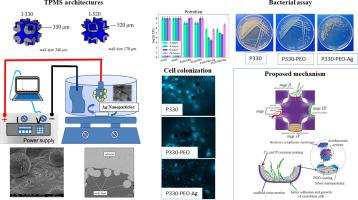Biomaterials Advances ( IF 7.9 ) Pub Date : 2021-01-08 , DOI: 10.1016/j.msec.2021.111870 Alexandr Myakinin , Amanzhol Turlybekuly , Alexander Pogrebnjak , Adam Mirek , Mikhael Bechelany , Iryna Liubchak , Oleksandr Oleshko , Yevheniia Husak , Viktoriia Korniienko , Katarzyna Leśniak-Ziółkowska , Dmitry Dogadkin , Rafał Banasiuk , Roman Moskalenko , Maksym Pogorielov , Wojciech Simka

|
Triply periodic minimal surfaces (TPMS) are known for their advanced mechanical properties and are wrinkle-free with a smooth local topology. These surfaces provide suitable conditions for cell attachment and proliferation. In this study, the in vitro osteoinductive and antibacterial properties of scaffolds with different minimal pore diameters and architectures were investigated. For the first time, scaffolds with TPMS architecture were treated electrochemically by plasma electrolytic oxidation (PEO) with and without silver nanoparticles (AgNPs) to enhance the surface bioactivity. It was found that the scaffold architecture had a greater impact on the osteoblast cell activity than the pore size. Through control of the architecture type, the collagen production by osteoblast cells increased by 18.9% and by 43.0% in the case of additional surface PEO bioactivation. The manufactured scaffolds demonstrated an extremely low quasi-elastic modulus (comparable with trabecular and cortical bone), which was 5–10 times lower than that of bulk titanium (6.4–11.4 GPa vs 100–105 GPa). The AgNPs provided antibacterial properties against both gram-positive and gram-negative bacteria and had no significant impact on the osteoblast cell growth. Complex experimental results show the in vitro effectiveness of the PEO-modified TPMS architecture, which could positively impact the clinical applications of porous bioactive implants.
中文翻译:

电化学生物活化Ti6Al4V 3D多孔支架的体外评估
三重周期性最小曲面(TPMS)以其先进的机械性能而闻名,并且具有平滑的局部拓扑结构且无皱纹。这些表面为细胞附着和增殖提供了合适的条件。在这项研究中,体外研究了具有不同最小孔径和结构的支架的骨诱导和抗菌特性。第一次,具有和不具有银纳米颗粒(AgNP)的等离子体电解氧化(PEO)对具有TPMS结构的支架进行电化学处理,以增强表面生物活性。发现支架结构对成骨细胞活性的影响大于孔径。通过控制结构类型,成骨细胞的胶原蛋白产量增加了18.9%,在进行额外的表面PEO生物活化的情况下增加了43.0%。制成的脚手架显示出极低的准弹性模量(与小梁和皮质骨相比),比散装钛的低5-10倍(6.4-11.4 GPa vs.100–105 GPa)。AgNPs对革兰氏阳性和革兰氏阴性细菌均具有抗菌性能,并且对成骨细胞的生长没有显着影响。复杂的实验结果表明,PEO修饰的TPMS体系结构的体外有效性可对多孔生物活性植入物的临床应用产生积极影响。

























 京公网安备 11010802027423号
京公网安备 11010802027423号